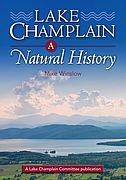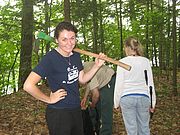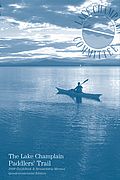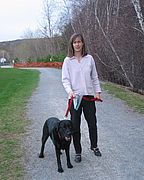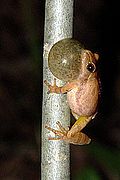Lake Champlain: A Natural History has won an IPPY Award from Independent Publishers. The group recognizes the best independently published books of the year. Our book tied for silver for Best Regional Non-Fiction in the US Northeast.
If you haven’t gotten your copy yet or sent one on to a fellow lake lover, you can make a purchase today at our secure website www.lakechamplaincommittee.org or by calling us at 802 658-1414. Read...
New York State Electric and Gas (NYSEG) has completed removal of contaminated wastes for an upland area of a former manufactured gas plant on Saranac Street in the City of Plattsburgh. The plant operated from 1896 to 1960, and the contaminants were by-products of gas production. Over 150,000 tons of tar-contaminated soils and over 7-million gallons of contaminated liquids were collected and treated. At this time, proposals are being considered for Phase II of the project which will address contaminated river sediments. Read...
Join in a fun day of trail maintenance and hiking at beautiful Niquette Bay, one of the stops on the Paddlers’ Trail. Individuals and families with children 8 and up are welcome to help us get this popular network of trails ready for summer. Lunch will be provided. Come prepared with sturdy boots, gloves, water, sunscreen and bug repellant. Please register in advance with Jessica Ricketson at 802 879-5680 or jessica.ricketson@ state.vt.us so we’ll be sure to have enough food!
This maintenance project is a collaborative effort of the Vermont Department of Forests, Parks and Recreation, the Girl Scouts, American Hiking Society, No Child Left Inside, and the Lake Champlain Committee. Read...
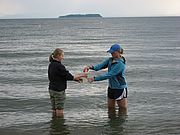
For the seventh consecutive year, the Lake Champlain Committee is coordinating a volunteer blue green algae monitoring program for near-shore areas of the lake. Citizen monitors collect water samples on a weekly basis which are analyzed by the University of Vermont. The program is critical to expanding knowledge of how, why, and when blooms form and what triggers them to turn toxic. It also provides data to public health agencies for posting about swimming safety. We need monitors to sample at Beggs Park in Essex, NY and High Rocks in Highgate Springs, VT. LCC will provide sampling equipment, training, and ongoing support. Willing volunteers need to be able to take water samples between 10AM and 2PM on Sundays or Mondays between July 6th and September 8th. LCC will arrange a Monday morning pick-up with the Essex volunteer. The High Rocks volunteer must deliver the samples to the Missisquoi National Wildlife Refuge Headquarters by Tuesday morning. Samples are taken in very shallow water, so a boat is not necessary so long as the volunteer has access to the shore. A short training session will be held on Monday June 29th. If you or anyone you know is interested please contact LCC staff scientist Mike Winslow at 802-658-1461 or mikew@ lakechamplaincommittee.org. Read...
The 2009 Quadricentennial edition of the Lake Champlain Paddlers’ Trail and Stewardship Manual will be mailed in June. Join or renew your membership at a level of $40 or more and we’ll mail you the informative guide to the Trail’s 37 locations that provide access to more than 700 campsites. Read...
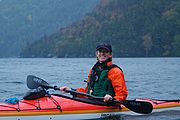
Even if air temperatures seem balmy, the lake takes much longer to warm up. Additionally, strong currents and the presence of springtime debris add to risks this time of year. Current Lake Champlain temperatures are in the 40s. If you are immersed in water that cold for a half hour, exhaustion and unconsciousness can set in. Water temperatures of less than 70 degrees Fahrenheit can cause you to lose precious body heat up to 25 times faster than comparable air temperatures. Water temperatures in many areas of Lake Champlain, particularly the Main Lake, never reach the 70s. Be cautious about heading out on the water and make sure you and your boat are properly equipped. Bring a weather radio or VHF with you and check the weather forecast repeatedly. Always wear a Personal Flotation Device (PFD). Nine out of ten drownings occur in inland waters, most within a few feet of safety. Most of the victims owned PFDs but died without them. A properly fitted, buoyant PFD can save your life, only if you wear it. Dress for the season. If kayaking or canoeing in cold water conditions (no matter what the air temperature is) wear a wetsuit or drysuit with an insulating layer. Here's to safe, fun adventures on the water. Read...
Over 3,800 individuals participated in this year’s Way to Go Week – an event to promote environmentally-friendly, healthy alternatives to driving solo. Thanks to everyone who joined in. Collectively we saved 254,633 miles of driving, 11,307 gallons of gas, over $23,000 in gas money, over $35,000 total in driving related expenses, 7,429 pounds of pollution and over 221,000 pounds of CO2 in just one week! Read...
Whether in the street, the park, or your yard, cleaning up after pets helps to keep the waters safe. Left unattended, pet waste leads to:
-Bacteria in the water that can close beaches and make people sick.
-Excess nutrients that cause algae blooms.
-Oxygen depletion when the poop breaks down.
What to do with the poop?
Flush It
The best option is to flush it down the toilet so it can be treated at the wastewater treatment facility or septic system.
Bury It
Burying the waste about 5” deep will allow soil micro-organisms to break it down while keeping the poop from being washed away by the next rainstorm.
Trash It
While not the best solution, putting pet waste in the trash is preferable to leaving it in place.
For more lake friendly tips, check out the Learn and Get Involved sections of our website and consider taking our Lake Protection Pledge.
Read...
As spring advances the world fills with sound. Months of winter’s muffled silence give way to a great symphony of singing, gurgling, croaking, and drumming. Yet what we hear as a joyous ensemble masks some nasty competition.
Birds are the best known chorus members. They communicate a variety of messages to others of their species through song, but mostly they say “stay away from my territory, unless you are a female ready to mate”. Researchers have shown that if a bird is removed from a territory, playing a recording of its song will prevent other birds from occupying the territory.
Not all birds rely upon song for auditory communication. Ruffed grouse cup and then vigorously flap their wings to create a drumming sound. Woodpeckers bang against trees not just to get food but also to communicate. Snipe and woodcock conduct aerial displays where sounds are created by the wind whistling through their feathers.
Read...

